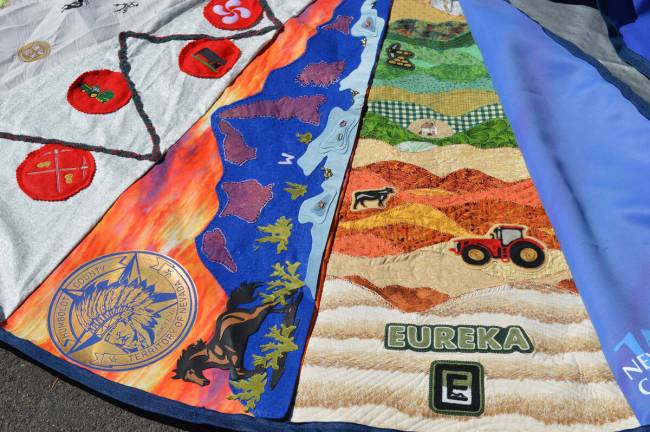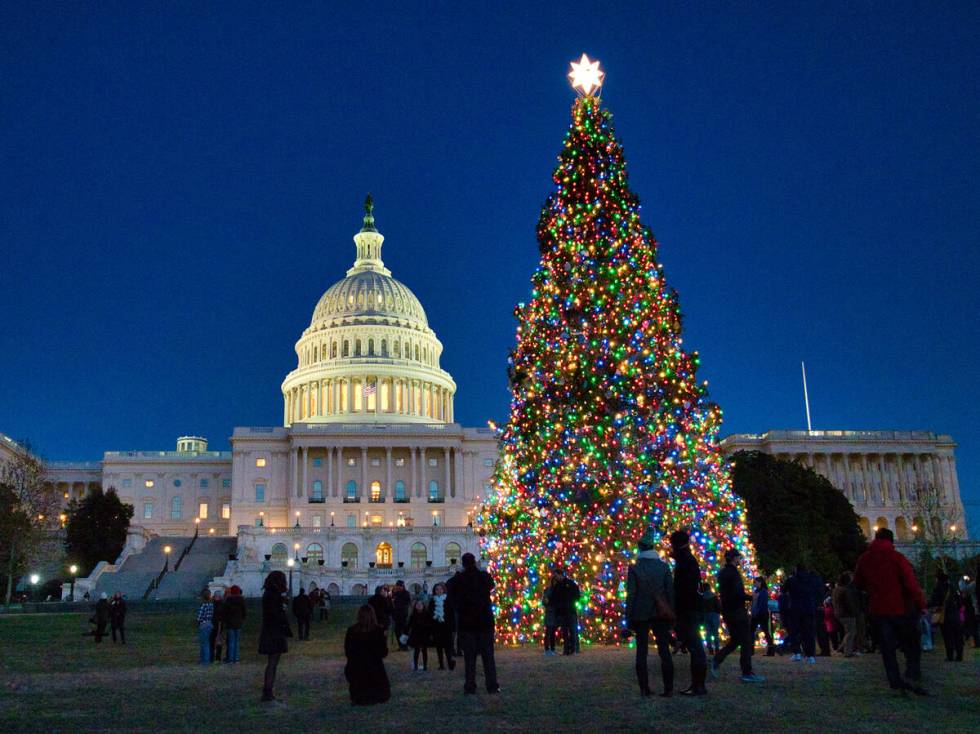It may be hard for Las Vegans to picture Nevada as a winter wonderland. But the state’s northern forests are already blanketed in snow, weighing down towering tree branches. Freshness fills the air, along with seldom heard winter birdsong and creaky trunks. Among these thousands of evergreens, one will soon be dressed in festive finery and introduced to the nation.
“The People’s Tree” is Nevada’s tree this winter. The U.S. Capitol Christmas tree hails from that Silver State wonderland for the first time in the program’s 55-year history. 
The 53-foot-tall, 100-year-old Nevada red fir — newly christened “Silver Belle” — was harvested at the end of October from the Carson Ranger District of the Humboldt-Toiyabe National Forest, the largest national forest in the Lower 48. The district encompasses 400,000 acres in far western Nevada and eastern California, from Reno to Sonora Pass and the gateway to Lake Tahoe. The Capitol tree is from the Mount Rose area near Reno, at about 8,000 feet in elevation.
Nevada’s deeply hued tree was chosen by Jim Kaufmann, executive director of the Capitol Grounds and Arboretum at the Architect of the Capitol, who also considered trees in the Spring Mountains near Las Vegas.
The tree comes from the western edge of Nevada’s expansive 2nd Congressional District, which spans the entire northern half of the state and its capital, Carson City. Mark Amodei, who represents that district, joined a group from the U.S. Forest Service early on in the tree selection process and they showed him photos of five trees in Southern Nevada. 
“I’m looking at those trees, and I’m going, those are good-looking trees, right? I’m looking at that, and I was worried. I’m like, ‘Holy moly,’ ” he says. “Then we look at the ones up here, and there was one which they ended up selecting. It was like, ‘There you go. That’s a perfect Christmas tree right there.’ ”
Amodei, a Nevada native, put the tree into historical context. Some could say this specific red fir’s history began more than 160 years ago, well before its first sprout, when the Comstock Lode was discovered near present-day Virginia City and logging was, for the most part, unregulated.
“They cut everything for Virginia City,” he says. “Everything you look at around there is second growth; there’s no original growth.”
These trees helped expand America’s railroads across Nevada, as loggers — mostly Chinese immigrants at the time — used them to transport lumber from Reno to Virginia City. 
“There are sayings, if you look at the history, where the forests of the Sierra are all entombed beneath Virginia City. That may be a little bit of an overstatement, but make no mistake about it, there was a ton of money spent on railroads to take it,” Amodei says.
The forest is alive and well today, rebuilt after a century of new growth from not just red fir but also Western white pine, sugar pine and other hardier species.
‘Perfect for securing ornaments’
Found in high-altitude regions of Oregon and California, red fir (Abies magnifica) is the largest tree species in the Sierra Nevada, and in Nevada’s portion, it is one of 37 tree species.
The tree is a collaborative effort, showing “what’s possible when state, federal, tribal and local partners work together with landowners, industry and other stakeholders to care for Nevada’s landscapes,” says Kacey KC, the Nevada state forester and firewarden. “Thanks to our Shared Stewardship Agreement, these partnerships are stronger than ever — and they’ve helped protect lives and property in nearly every recent wildfire, including right where Silver Belle will be harvested.” 
Megan Lahti, professor of biology at Truckee Meadows Community College, notes the red fir, which can live several hundred years, is named for its deep red bark, which is thick with deep cracks and fissures in older examples. Beyond Christmas trees, red firs are used for lumber, paper and pulp.
Red firs support more than humans’ holiday whims. Lahti says fallen trees provide important den sites for ground-dwelling animals like martens. Branches provide nesting sites for woodpeckers, owls and chickadees. They’re also home to bat roost and foraging sites, and provide food for mammals like squirrels ahead of winter. Its leaves are eaten by deer, bears, rabbits and beavers. Its seeds are winged, carried by the wind in fall to produce the next generation of trees.
The red fir, like most Western species, has its vulnerabilities: mistletoe, “although a sign of love, life and fertility,” Lahti says, steals nutrients from the tree, leaving it susceptible to harmful insects and fungi. They’re more or less adapted to wildfire the older they get, but are threatened by drought and climate change in some areas.
Public lands in Nevada, much like the one where the red fir grows, are also under threat of encroaching development and mining projects, among other human activities. Even amid the holiday spirit, this isn’t lost on Olivia Tanager, director of the Sierra Club’s Toiyabe Chapter. 
“At a time when the threats to our public lands are at an all time high, we hope the Capitol Christmas tree that originates from the largest forest service unit in the Lower 48 will serve as a reminder to all in Washington that public lands are a critical part of Nevada’s identity and one of the best parts of the United States,” she says. “The light of this tree should remind our leaders that the movement to protect our forests, waters and open spaces is vast, growing and unstoppable.”
The red fir is an excellent selection for the nation’s Christmas tree, Lahti said, because of its symmetrical shape and eye-pleasing silver-blue foliage.
“The leaves have curved tips, often likened to a hockey stick, which are perfect for securing ornaments and decorations in place, even when your curious cat decides to summit the tree,” she says.
‘A symbol of Nevada’s rich landscapes’
To harvest the tree, workers secured the top section to a crane to prevent damaging the branches as the trunk was cut. All 4,600 pounds of greenery were then carefully lowered onto a custom-made trailer built in the National Guard hangar in Reno. The trailer keeps the tree hydrated, healthy and comfortable during two weeks of whistle-stops. 
The tree’s first public appearance was rolling down Main Street in Carson City for the Nevada Day celebration on Nov. 1. From there, the fir visited Lovelock, Elko, Ely and Las Vegas with a stop at Hoover Dam before heading east through the U.S., finally landing at Joint Base Andrews in Maryland.
“Silver Belle” will be displayed on the West Lawn of the U.S. Capitol with 10,000 locally handmade ornaments for the holiday season, following a tradition that highlights America’s 154 national forests across 741 million acres. 
The Dec. 2 lighting ceremony will include Virginia City’s Grady Armstrong, a fourth grader from the Storey County School District who won the U.S. Capitol Christmas tree essay contest. He will travel to D.C. to light the tree and read his essay alongside Speaker of the House Mike Johnson. The essay contest’s theme was “Starry Skies to Neon Lights: Spirit of the Silver State.”
“This historic moment shines a national spotlight on our state’s natural beauty and the communities that care for it,” Nevada Gov. Joe Lombardo said. “This is more than a holiday tradition, it’s a symbol of Nevada’s rich landscapes, strong forestry heritage, and the spirit that unites our communities.” ◆















